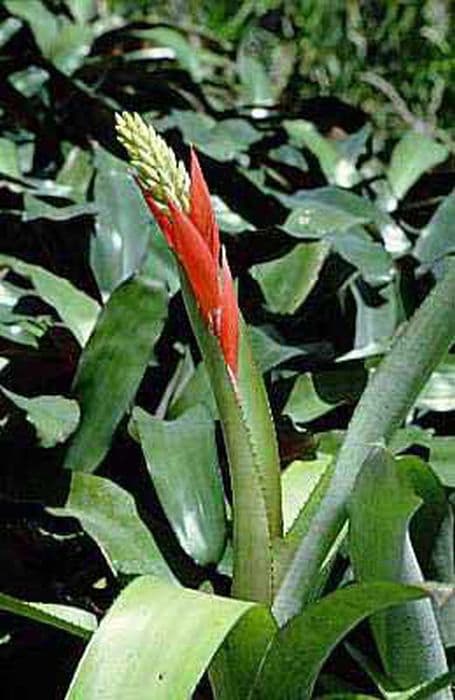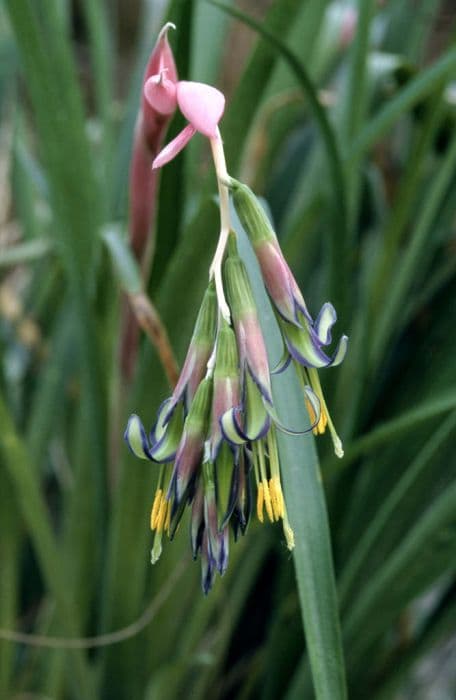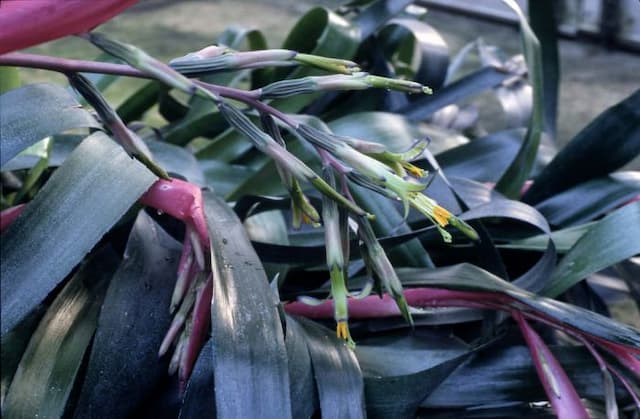Aechmea 'Blue Rain' (PBR)

ABOUT
Aechmea 'Blue Rain' is an eye-catching plant known for its striking coloration and unusual floral displays. The plant typically has a rosette of broad, strap-like leaves that are a deep green with a glossy sheen. The leaves can have sharp teeth along the margins and may display a faint silver banding, which adds texture and visual interest. The most remarkable feature of Aechmea 'Blue Rain' is its floral bracts and blooms. The bracts are a vivid shade of pink to red, arranged in a conical to cylindrical shape, giving the inflorescence a very ornamental and architectural look. Emerging from these bracts, the flowers have a brilliant blue or violet hue that creates a stunning contrast against the warm tones of the bracts. The blossoms can appear almost luminescent and may have a delicate, waxy appearance. Overall, the plant exudes a tropical aura and its lush foliage coupled with its dynamic inflorescence makes it a popular choice for indoor decoration or for use in subtropical garden displays where it adds a burst of color and an exotic feel. It's robust and striking, and its vibrant color palette of green, pink, red, and blue emphasizes its ornamental value, making it a favorite among plant enthusiasts looking for a spectacular visual statement.
About this plant
 Names
NamesSynonyms
Blue Rain Bromeliad, Urn Plant
Common names
Aechmea 'Blue Rain' (PBR)
 Toxicity
ToxicityTo humans
The Aechmea 'Blue Rain', commonly known as a type of bromeliad, is not known to be poisonous to humans. However, as with any plant, individual cases of sensitivity could cause mild irritation, and it is generally advised to avoid ingesting plant material that isn't known to be edible.
To pets
For pets, the bromeliad Aechmea 'Blue Rain' is generally considered non-toxic. Pets that chew on or ingest parts of this plant typically do not suffer from any toxic reactions. However, ingestion can still potentially lead to gastrointestinal discomfort or irritation, so it's best to discourage pets from eating ornamental plants.
 Characteristics
CharacteristicsLife cycle
Perennials
Foliage type
Evergreen
Color of leaves
Green
Flower color
Blue
Height
1-2 feet (30-60 cm)
Spread
1-2 feet (30-60 cm)
Plant type
Bromeliad
Hardiness zones
10
Native area
Brazil
Benefits
 General Benefits
General Benefits- Enhances Aesthetics: Adds a vibrant splash of blue and green to indoor and outdoor spaces with its striking inflorescences and glossy foliage.
- Low Maintenance: Requires minimal care, making it suitable for busy individuals or those not adept at gardening.
- Durable: Tolerates a range of conditions once established and doesn't need frequent repotting.
- Long-Lasting Blooms: Produces flowers that can last for several months, providing extended visual interest.
- Increases Humidity: Like many bromeliads, this plant releases moisture into the air through its leaves, which can be beneficial in dry indoor environments.
- Non-Toxic: Safe to keep in homes with pets and children, as it is not known to be toxic upon ingestion.
- Space Efficiency: Its upright growth habit allows it to fit well in tight spaces or as part of a larger indoor plant collection.
- Versatile Decor: Works well as a standalone showpiece or part of a mixed display, fitting into a variety of decor styles.
- Promotes Biodiversity: When planted outdoors, it can attract pollinators like birds and insects, contributing to the health of local ecosystems.
- Year-Round Interest: With evergreen foliage, it provides color and life to spaces even when not in bloom.
 Medical Properties
Medical PropertiesThis plant is not used for medical purposes.
 Air-purifying Qualities
Air-purifying QualitiesThis plant is not specifically known for air purifying qualities.
 Other Uses
Other Uses- Aechmea 'Blue Rain' can be used in thematic garden designs, such as tropical or rainforest themes, adding vibrant color and exotic appeal.
- The plant's sturdy leaves can support small objects for decorative purposes in fairy gardens or miniature displays.
- Floral artists sometimes incorporate the long-lasting bracts of Aechmea 'Blue Rain' into their arrangements for a splash of color that endures.
- The bromeliad can be grown in outdoor ponds or water features, provided there is no risk of frost, to create an unusual aquatic landscape.
- Dried bracts of the plant can be used in crafts for creating exotic-looking bookmarks, greeting cards, or scrapbooking elements.
- Educationally, Aechmea 'Blue Rain' is an excellent specimen to discuss topics such as plant adaptation, symbiosis, and epiphytism in biology classes.
- Photographers might use Aechmea 'Blue Rain' as a subject for macro photography, exploring the plant's textures and colors.
- The unique structure of the plant can be inspirational in biomimicry design projects, particularly for water collection and distribution systems.
- Its ability to bloom for a long period makes the Aechmea 'Blue Rain' a good candidate for tabletop displays at events where flowers are needed to last.
- Aechmea 'Blue Rain' can be used as natural packaging or presentation material for eco-friendly gifts, with its robust leaves holding small items.
Interesting Facts
 Feng Shui
Feng ShuiThe Bromeliad 'Blue Rain' is not used in Feng Shui practice.
 Zodiac Sign Compitability
Zodiac Sign CompitabilityThe Bromeliad 'Blue Rain' is not used in astrology practice.
 Plant Symbolism
Plant Symbolism- Uniqueness: The vibrant blue and purple hues of Aechmea 'Blue Rain' signify its distinctiveness, representing standing out from the crowd and celebrating individuality.
- Beauty: The striking appearance of the plant, with its lush green foliage and bright inflorescence, symbolizes natural beauty and the appreciation for aesthetic qualities.
- Tropical Exuberance: As Aechmea 'Blue Rain' is native to tropical regions, it represents the lushness and vibrant energy of the tropics, and a sense of adventure and exoticism.
- Protection: The sturdy leaves and the way they form a protective rosette around the central flower spike can symbolize safety and a protective barrier.
- Longevity: Given that the Aechmea 'Blue Rain' bloom can last for several months, it is often connected with endurance and long-lasting relationships or projects.
 Water
WaterThe Blue Rain Bromeliad prefers to have its central cup kept filled with water, ideally with rainwater or distilled water. Water the central cup every 1 to 2 weeks, replacing any stagnant water to prevent bacterial growth. The soil should be lightly moist but never soggy, requiring approximately one-quarter to one-half gallon of water every fortnight, depending on the size of the plant and the environmental conditions. During the winter, reduce watering to prevent root rot as growth slows down.
 Light
LightFor the Blue Rain Bromeliad, bright, indirect sunlight is best to maintain its vibrant colors and overall health. A spot near an east or west-facing window that receives some morning or late afternoon sun, without harsh direct light that could scorch the leaves, is ideal. Avoid placing it in too much shade or deep interior rooms where it might not receive enough light to thrive.
 Temperature
TemperatureThe Blue Rain Bromeliad thrives in temperatures between 55 and 80 degrees Fahrenheit. They can survive minimum temperatures down to around 40 degrees Fahrenheit but should be protected from frost. Ideally, keep this plant in a warm environment without sudden temperature fluctuations to promote healthy growth.
 Pruning
PruningPruning the Blue Rain Bromeliad is primarily done to remove dead or dying leaves and spent flower spikes to encourage new growth. Prune as necessary, typically after blooming or when leaves become brown or damaged. The best time for pruning is post-flowering when the plant starts producing offsets, or "pups," which can be left to grow or removed to propagate new plants.
 Cleaning
CleaningAs needed
 Soil
SoilThe Blue Rain Bromeliad prefers a well-draining, airy potting mix, typically a blend of orchid bark, perlite, and peat moss. The ideal soil pH for the Blue Rain Bromeliad should be slightly acidic to neutral, ranging from 5.5 to 7.0.
 Repotting
RepottingBlue Rain Bromeliads should be repotted every few years or when the plant outgrows its container. They prefer to be somewhat root-bound, so frequent repotting is not necessary.
 Humidity & Misting
Humidity & MistingBlue Rain Bromeliads thrive in high humidity conditions, with an ideal range of 60-75%. They benefit from humid environments but can adapt to average indoor humidity levels.
 Suitable locations
Suitable locationsIndoor
Place in bright, indirect light and keep at warmer temperatures.
Outdoor
Protect from frost, provide shade, and ensure high humidity.
Hardiness zone
10-11 USDA
 Life cycle
Life cycleThe Aechmea 'Blue Rain,' commonly referred to as Bromeliad 'Blue Rain,' initially starts its life as a seed or a pup (offset) from a parent plant. The seed germinates or the pup roots in a well-drained, moisture-retentive substrate, developing a rosette of strappy leaves. As the plant matures, it forms a central tank which collects water and nutrients. After reaching maturity, which can take several years, the bromeliad 'Blue Rain' produces a striking flower spike with vivid blue and pink bracts which may last for several months. Post-flowering, the plant slowly begins to decline, but before dying, it produces offsets around its base. These offsets can be separated from the parent and potted on to continue the cycle, as the original plant completes its life after flowering and does not bloom again.
 Propogation
PropogationPropogation time
Spring-Early Summer
Aechmea 'Blue Rain', commonly known as Blue Rain Bromeliad, is typically propagated through the removal and planting of offsets, also known as "pups." These pups usually form around the base of the plant after the parent plant has flowered. The best time to propagate Blue Rain Bromeliads by this method is during the warmer months when they are actively growing, generally from spring to early fall. Once a pup reaches about one-third of the size of the parent plant and has several sets of leaves, it can be gently separated with a clean, sharp knife. The pup should then be potted in a well-draining bromeliad or orchid potting mix and kept in bright, indirect light while maintaining slight moisture in the soil until it establishes a strong root system. After a few weeks to a couple of months, the pup will begin to grow on its own and eventually become a mature plant just like the parent.









